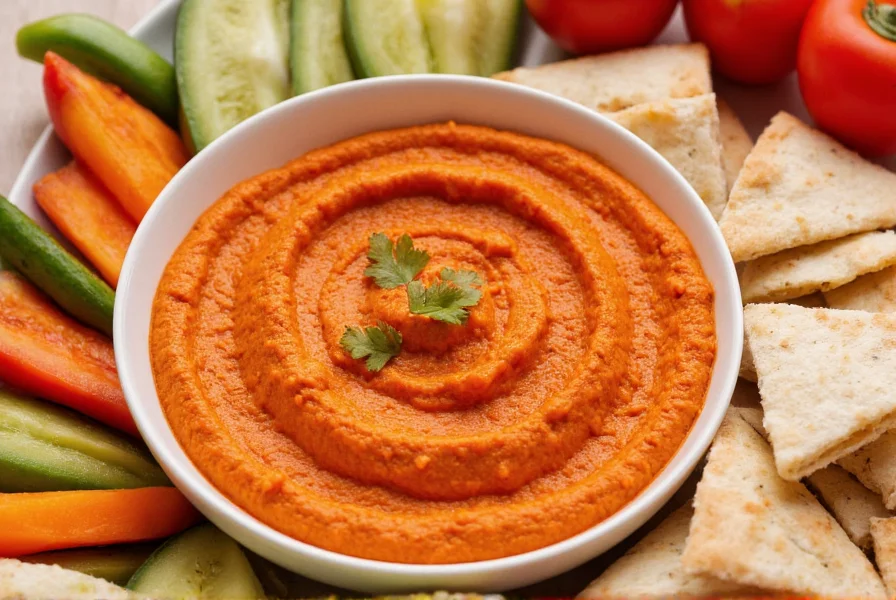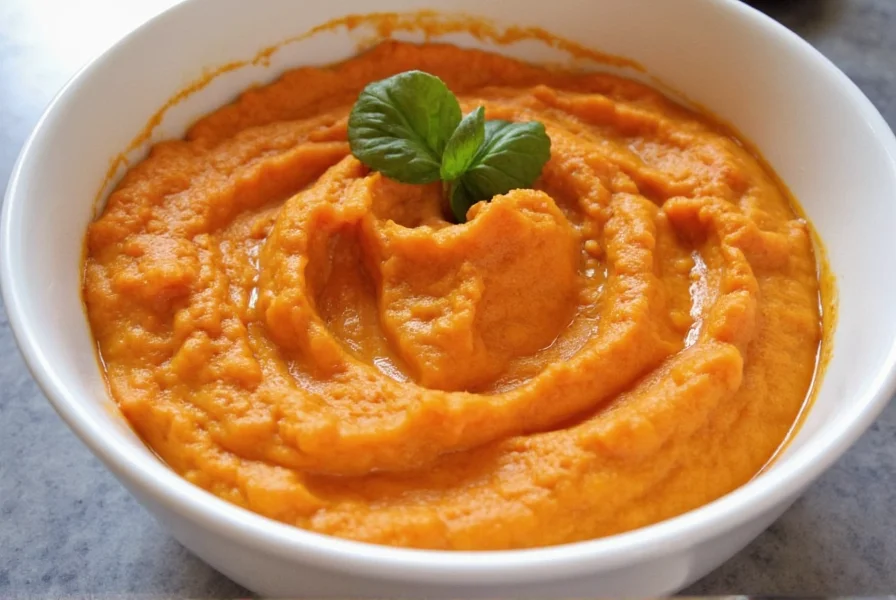Roasted red pepper hummus transforms the classic Middle Eastern dip with a burst of color and flavor. This popular variation maintains the protein-rich foundation of traditional hummus while introducing the natural sweetness and smokiness of roasted peppers. Understanding how to properly prepare and use this versatile spread can elevate your meal planning and snack options significantly.
The Distinctive Qualities of Red Pepper Hummus
Unlike standard hummus, red pepper hummus incorporates roasted bell peppers that create a unique flavor dimension. The roasting process caramelizes the peppers' natural sugars, producing a sweet-smoky taste that complements the earthy chickpeas. This variation typically has a brighter orange-red color and slightly thinner consistency than plain hummus, making it particularly suitable as a sandwich spread or vegetable dip.
When preparing homemade red pepper hummus, the quality of roasted peppers significantly impacts the final product. Freshly roasted peppers provide superior flavor compared to jarred varieties, though convenient jarred options work well for easy red pepper hummus recipe applications when time is limited.
Essential Ingredients Breakdown
The magic of exceptional red pepper hummus comes from balancing just a few key components. Each ingredient serves a specific purpose in creating the perfect texture and flavor profile.
| Ingredient | Function | Recommended Quantity |
|---|---|---|
| Cooked chickpeas | Protein base and creamy texture | 1.5 cups (canned or home-cooked) |
| Roasted red peppers | Flavor complexity and color | 1 cup (drained well) |
| Tahini | Richness and authentic flavor | 1/4 cup (high-quality) |
| Fresh lemon juice | Brightness and balance | 2-3 tablespoons |
| Garlic | Pungent depth | 1 small clove (optional) |
Step-by-Step Preparation Guide
Creating creamy red pepper hummus texture requires attention to technique. Start by ensuring your roasted peppers are thoroughly drained—excess liquid is the primary cause of watery hummus. For optimal results when making red pepper hummus from scratch, roast fresh bell peppers directly over a gas flame or under a broiler until charred, then steam in a covered bowl before peeling.
The blending process significantly affects texture. Begin by processing tahini and lemon juice for 1-2 minutes to create an emulsion before adding other ingredients. This technique, borrowed from traditional hummus preparation, yields noticeably smoother results. Add chickpeas and roasted peppers gradually while the processor runs, scraping down sides as needed.
For restaurant-quality consistency, consider removing chickpea skins or using aquafaba (chickpea cooking liquid) instead of water to adjust thickness. The ideal best roasted red pepper hummus should coat the back of a spoon without running off.
Serving Suggestions and Culinary Applications
Red pepper hummus shines in numerous applications beyond standard dipping. Its vibrant color and balanced flavor make it particularly versatile:
- As a sandwich spread that won't make bread soggy
- Mixed into grain bowls for added creaminess
- Thinned with olive oil for a salad dressing
- As a base for Mediterranean-inspired pizza
- Stuffed into chicken breasts or mushrooms
When serving as a dip, pair with contrasting colors and textures: cucumber slices, carrot sticks, pita triangles, and radish provide visual appeal while complementing the sweet-smoky flavor. For entertaining, swirl the hummus in a shallow dish and top with a drizzle of olive oil, smoked paprika, and fresh herbs.

Nutritional Advantages of Red Pepper Hummus
The addition of red peppers significantly enhances the nutritional profile of traditional hummus. Bell peppers contain three times more vitamin C than oranges by weight, plus substantial vitamin A and multiple antioxidants. This makes red pepper hummus nutritional benefits particularly noteworthy for immune support and skin health.
Compared to regular hummus, red pepper variation typically contains:
- Higher levels of carotenoids and vitamin C
- Slightly lower fat content (when using minimal tahini)
- Increased antioxidant capacity
- Similar protein and fiber content from chickpeas
A standard 2-tablespoon serving provides approximately 50-70 calories, 2-3 grams of plant-based protein, and 1-2 grams of dietary fiber. The healthy fats from tahini and olive oil contribute to satiety and nutrient absorption.
Proper Storage Techniques
To maximize freshness of your red pepper hummus storage tips, transfer to an airtight container immediately after preparation. Press plastic wrap directly onto the hummus surface before sealing to prevent oxidation and color fading. Properly stored, homemade red pepper hummus maintains quality for 4-5 days in the refrigerator.
For longer preservation, freeze in portion-sized containers for up to 3 months. Thaw overnight in the refrigerator and stir well before serving, as separation may occur. Avoid freezing in glass containers due to expansion risks.

Troubleshooting Common Preparation Issues
Even experienced cooks encounter challenges with red pepper hummus vs regular hummus preparation. Here's how to address frequent issues:
- Too watery: Excess liquid from peppers is the usual culprit. Drain roasted peppers thoroughly and consider adding 1-2 tablespoons of cooked chickpeas to absorb moisture.
- Lacking depth: Boost flavor with 1/4 teaspoon smoked paprika or a few drops of liquid smoke to enhance the roasted pepper notes.
- Grainy texture: Process tahini and lemon juice longer before adding other ingredients, and consider removing chickpea skins for ultra-smooth results.
- Overpowering garlic: Raw garlic intensifies over time. If making ahead, reduce initial amount or use roasted garlic instead.
Frequently Asked Questions
Can I use jarred roasted red peppers for homemade red pepper hummus?
Yes, high-quality jarred roasted red peppers work well for convenient preparation. Drain them thoroughly—pressing gently between paper towels—to remove excess liquid that would thin your hummus. For best results in your red pepper hummus recipe easy version, choose peppers packed in water rather than oil.
Why is my red pepper hummus bitter?
Bitterness typically comes from either over-processing garlic or using low-quality tahini. Limit garlic to one small clove maximum, and always use fresh, well-stirred tahini. If bitterness occurs, balance with additional lemon juice (1/2 teaspoon at a time) or a pinch of sugar.
How can I make red pepper hummus without tahini?
For tahini-free red pepper hummus, substitute with 2-3 tablespoons of Greek yogurt or additional olive oil. The flavor profile will differ slightly, but you'll maintain creaminess. Some recipes use sunflower seed butter as a nut-free alternative that mimics tahini's richness.
What's the best way to roast peppers for authentic red pepper hummus?
For optimal flavor in your best roasted red pepper hummus, place whole peppers directly over a gas flame or under a broiler, turning frequently until completely blackened. Transfer to a covered bowl for 10 minutes to steam, then remove skins under running water. This method creates deeper caramelization than oven-roasting.
Can red pepper hummus be made in advance for meal prep?
Absolutely—red pepper hummus actually improves in flavor after 24 hours as ingredients meld. Store in an airtight container with plastic wrap pressed directly on the surface to prevent discoloration. This makes it ideal for weekly meal prep, maintaining quality for 4-5 days refrigerated. Stir well before serving if separation occurs.











 浙公网安备
33010002000092号
浙公网安备
33010002000092号 浙B2-20120091-4
浙B2-20120091-4